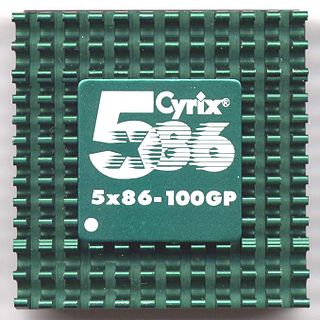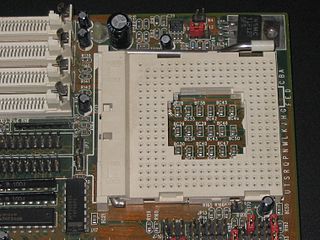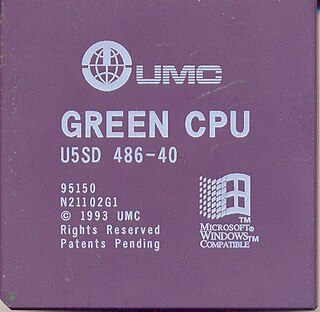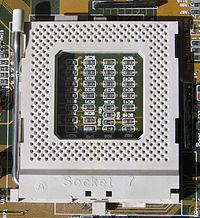
Athlon is the brand name applied to a series of x86-compatible microprocessors designed and manufactured by AMD. The original Athlon was the first seventh-generation x86 processor and the first desktop processor to reach speeds of one gigahertz (GHz). It made its debut as AMD's high-end processor brand on June 23, 1999. Over the years AMD has used the Athlon name with the 64-bit Athlon 64 architecture, the Athlon II, and Accelerated Processing Unit (APU) chips targeting the Socket AM1 desktop SoC architecture, and Socket AM4 Zen microarchitecture. The modern Zen-based Athlon with a Radeon Graphics processor was introduced in 2019 as AMD's highest-performance entry-level processor.

The Intel 486, officially named i486 and also known as 80486, is a microprocessor. It is a higher-performance follow-up to the Intel 386. The i486 was introduced in 1989. It represents the fourth generation of binary compatible CPUs following the 8086 of 1978, the Intel 80286 of 1982, and 1985's i386.

The K6 microprocessor was launched by AMD in 1997. The main advantage of this particular microprocessor is that it was designed to fit into existing desktop designs for Pentium-branded CPUs. It was marketed as a product that could perform as well as its Intel Pentium II equivalent but at a significantly lower price. The K6 had a considerable impact on the PC market and presented Intel with serious competition.

The Pentium is a fifth generation, 32-bit x86 microprocessor that was introduced by Intel on March 22, 1993, as the very first CPU in the Pentium brand. It was instruction set compatible with the 80486 but was a new and very different microarchitecture design from previous iterations. The P5 Pentium was the first superscalar x86 microarchitecture and the world's first superscalar microprocessor to be in mass production—meaning it generally executes at least 2 instructions per clock mainly because of a design-first dual integer pipeline design previously thought impossible to implement on a CISC microarchitecture. Additional features include a faster floating-point unit, wider data bus, separate code and data caches, and many other techniques and features to enhance performance and support security, encryption, and multiprocessing, for workstations and servers when compared to the next best previous industry standard processor implementation before it, the Intel 80486.

Celeron is Intel's brand name for low-end IA-32 and x86-64 computer microprocessor models targeted at low-cost personal computers.

Cyrix Corporation was a microprocessor developer that was founded in 1988 in Richardson, Texas, as a specialist supplier of floating point units for 286 and 386 microprocessors. The company was founded by Tom Brightman and Jerry Rogers.

The Pentium III brand refers to Intel's 32-bit x86 desktop and mobile CPUs based on the sixth-generation P6 microarchitecture introduced on February 28, 1999. The brand's initial processors were very similar to the earlier Pentium II-branded processors. The most notable differences were the addition of the Streaming SIMD Extensions (SSE) instruction set, and the introduction of a controversial serial number embedded in the chip during manufacturing. The Pentium III is also a single-core processor.

The Pentium Pro is a sixth-generation x86 microprocessor developed and manufactured by Intel and introduced on November 1, 1995. It introduced the P6 microarchitecture and was originally intended to replace the original Pentium in a full range of applications. While the Pentium and Pentium MMX had 3.1 and 4.5 million transistors, respectively, the Pentium Pro contained 5.5 million transistors. Later, it was reduced to a more narrow role as a server and high-end desktop processor and was used in supercomputers like ASCI Red, the first computer to reach the trillion floating point operations per second (teraFLOPS) performance mark. The Pentium Pro was capable of both dual- and quad-processor configurations. It only came in one form factor, the relatively large rectangular Socket 8. The Pentium Pro was succeeded by the Pentium II Xeon in 1998.

The Cyrix 5x86 was a line of x86 microprocessors designed by Cyrix and released on June 5 of 1995. Cyrix, being a fabless company, had the chips manufactured by IBM. The line came out about 5 months before the more famous Cyrix 6x86. The Cyrix 5x86 was one of the fastest CPUs ever produced for Socket 3 computer systems. With better performance in most applications than an Intel Pentium processor at 75 MHz, the Cyrix Cx5x86 filled a gap by providing a medium-performance processor option for 486 Socket 3 motherboards.

The Am5x86 processor is an x86-compatible CPU announced in November of 1995 by AMD for use in 486-class computer systems. It began shipping in December of 1995, with a base price of $93 per unit in bulk quantities. Before being released, it was in development under the codename "X5".
The PR system was a figure of merit developed by AMD, Cyrix, IBM Microelectronics and SGS-Thomson in the mid-1990s as a method of comparing their x86 processors to those of rival Intel. The idea was to consider instructions per cycle (IPC) in addition to the clock speed, so that the processors become comparable with Intel's Pentium that had a higher clock speed with overall lower IPC.
The Pentium OverDrive was a microprocessor marketing brand name used by Intel, to cover a variety of consumer upgrade products sold in the mid-1990s. It was originally released for 486 motherboards, and later some Pentium sockets. Intel dropped the brand, as it failed to appeal to corporate buyers, and discouraged new system sales.

Super Socket 7, also referred to as Super 7, is a hardware-level extension of the Socket 7 ZIF socket specification for x86 processors. Compatible motherboards and chipsets use a standard Socket 7 connection for the CPU, while adding certain features including a maximum 100 MHz front-side bus and support for AGP graphics cards.

Socket 370 is a CPU socket first used by Intel for Pentium III and Celeron processors to first complement and later replace the older Slot 1 CPU interface on personal computers. The "370" refers to the number of pin holes in the socket for CPU pins.

The WinChip series was a low-power Socket 7-based x86 processor designed by Centaur Technology and marketed by its parent company IDT.

In computer hardware, a CPU socket or CPU slot contains one or more mechanical components providing mechanical and electrical connections between a microprocessor and a printed circuit board (PCB). This allows for placing and replacing the central processing unit (CPU) without soldering.

Socket 3 was a series of CPU sockets for various x86 microprocessors. It was sometimes found alongside a secondary socket designed for a math coprocessor chip, such as the 487. Socket 3 resulted from Intel's creation of lower voltage microprocessors. An upgrade to Socket 2, it rearranged the pin layout. Socket 3 is compatible with 168-pin socket CPUs.

The Rise mP6 was a superpipelined and superscalar microprocessor designed by Rise Technology to compete with the Intel Pentium line.

The UMC Green CPU was an x86-compatible microprocessor produced by UMC, a Taiwanese semiconductor company, in the early- to mid-1990s. It was offered as an alternative to the Intel 80486 with which it was pin compatible, enabling it to be installed in most 80486 motherboards. All models had power management features intended to reduce electricity consumption.


















